Cereal grain products and other foods stored in kitchen cabinets, pantries or other areas in the home may become infested with insects or other organisms. These food invaders are commonly referred to as "pantry pests." Nearly all dry, stored human food products as well as dry pet food and birdseed are susceptible. Pantry pests eat and contaminate the products, rendering them useless for consumption and can leave infested foods to crawl or fly around the house. When this happens, they become an annoyance for many people.
Control of stored product pests begins with a careful examination of all susceptible materials to find and identify the pests and the extent of the infestation. This publication lists only the most common arthropod pests of stored products in Missouri and gives some brief information about their biology, behavior and treatment. Most of these pests are beetles, moths, mites or psocids.
Flour and grain beetles
Small reddish brown beetles in and around stored cereal grain products usually are the first signs of an infestation called "bran bugs." While this common name is applied to several different insects, those most often encountered are the saw-toothed grain beetle, confused flour beetle and red flour beetle
Saw-toothed grain beetle
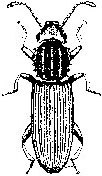 Saw-toothed grain beetle.
Saw-toothed grain beetle.
This insect gets its name from six toothlike projections located on the adult beetle on each side of the thorax just behind the head. This small insect is about 1/10 inch long, slender, flat, and dark red or brown. This beetle feeds on most grains and cereal products, nuts, seeds, yeasts, dried meats, dried fruits and candy. It readily penetrates packaged foods and may be brought into the home in groceries.
The eggs of this beetle are laid on or near food products and hatch into small yellowish white, grublike larvae. After several weeks of feeding, the larvae form a protective covering by sticking small bits of the food material together. Within this covering, they pupate and become immobile. A week or so later, they emerge as adult beetles. The adults may live for two or three years.
Confused flour beetle and red flour beetle
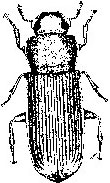 Red flour beetle.
Red flour beetle.
The confused flour beetle is reddish brown and about 1/7 inch long. The red flour beetle so closely resembles the confused flour beetle in appearance and habits that they are nearly impossible to distinguish without the help of an expert. This beetle feeds on a wide variety of foods, including processed grains, cereal products and other starchy materials, beans, peas, baking powders, dried fruits, some prescription drugs and even cayenne pepper.
Hundreds of these insects may live and reproduce in a small box or bag of infested food. The adults can migrate throughout the kitchen and infest any food products that are attractive to them, especially foods in open containers that are undisturbed for long periods.
The adult female beetle deposits small sticky eggs, which become covered by the food (flour, meal, etc.). Small white grubs (larvae) hatch from these eggs and tunnel through the food, feeding until they are about 1/6 inch long. They then come to the surface and pupate or transform from the wormlike larval stage into an immobile form, which later becomes the adult. The adults quickly mate and start laying eggs. The adults reinfest the same area or move on to infest other containers. Under ideal conditions, a complete generation from egg to adult develops in less than two months.
Anobiid beetles
Cigarette beetle
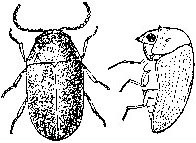 Cigarette beetle.
Cigarette beetle.
The cigarette beetle and drugstore beetle infest a wide variety of foods. Both adults and larvae cause damage to stored products. Both species belong to the family Anobiidae and are similar in appearance and habits. They are about 1/10 inch long and covered with small "hairs," which give them a silky, yellowish brown color. The head is tucked down beneath the front of the body and cannot be seen from above. The legs usually extend only slightly past the edges of their cylindrical bodies. Adult drugstore beetles are most readily distinguished from cigarette beetles by the three-segmented club of the antenna. The wing covers of cigarette beetles are smooth, while those of the drugstore beetle have faint lines running lengthwise. The grublike larvae of both species are C-shaped in appearance and are creamy white except for the yellow head and brown mouthparts. Drugstore beetle larvae are not as "hairy" as the cigarette beetle larvae.
Cigarette beetles are a serious pest in tobacco warehouses, attacking stored bundles or processed items such as cigars and chewing tobacco. It also readily infests cottonseed meal mills, furniture factories and libraries. Some other materials that cigarette beetles infest are grains and cereal products; various dried fruits (raisins and dates); spices such as aniseed, ginger, nutmeg and pepper; dried fish; drugs; seeds; and furniture upholstered in flax and straw. This beetle usually has three generations in a year. Under favorable conditions of high uniform temperatures, high humidity and protection from rapid evaporation, the life cycle continues uninterrupted and up to five or six generations can occur annually.
Drugstore beetle
 Drugstore beetle.
Drugstore beetle.
Drugstore beetles have an even more varied diet than cigarette beetles. This beetle can attack almost any dried food and can use as a food source many items that are inedible to humans. Infested materials include bakery products, flour, meal, cereals, cayenne pepper and other spices, cosmetics, prescription drugs and even strychnine. This insect has been known to bore through a whole shelf of books as well as perforate tinfoil and sheet lead. Drugstore beetles can produce several generations a year under favorable conditions of abundant food and warm temperatures.
Dermestid beetles
Hide beetles belong to the family Dermestidae. They are scavengers that feed on a wide variety of products of both plant and animal origin. The larvae do most of the damage. Adults are thought to feed mainly on flower pollen outdoors. Adults are small, oval, convex beetles varying in length from 1/8 to 1/4 inch. They are usually hairy or covered with scales. Sometimes the color patterns of the hairs and scales are helpful in identification as most species have a distinct color pattern. The larval stages are generally tubular shaped, brownish, covered with relatively long hairs, and may reach about 1/4 inch in length when mature. Some species have bundles of specialized hairs on the last three or four segments while others have a long terminal tuft of hairs.
Cabinet beetles
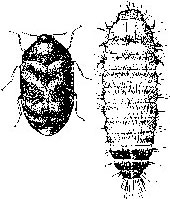 Cabinet beetle.
Cabinet beetle.
Several species of this group are common pantry pests that prefer cereal grains. The fuzzy, slow-moving larvae are what are most often found in infested food products. The adults are likely to be found around lights or windows in the area of the infested food product.
Carpet beetles
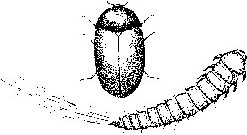 Black carpet beetle.
Black carpet beetle.
These beetles prefer food of animal origin. The larval stages may also feed on carpets, clothing, furniture or other household items that are made of animal products. Their occasional invasion into food products of plant origin is typically by accident. The most common species in this group are the black carpet beetle and the varied carpet beetle.
Larder beetles
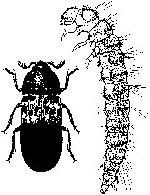 Larder beetle.
Larder beetle.
Larder beetles prefer products of animal origin such as dried meat and cheese. They are often found infesting stored pet foods. The larval stages only occasionally invade food products of plant origin.
Weevils
Seed weevils
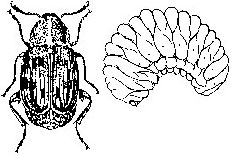 Bean weevil.
Bean weevil.
Several species of the beetle family Bruchidae damage stored dry beans and peas. The most common species in Missouri are the cowpea weevil and bean weevil. Adults lay their eggs on the surface of pods in the field or on the surface of seeds in storage. The grublike larvae bore directly through the seeds. Adult weevils are short, stout-bodied beetles about 3/16 inch long with the wing covers shortened and not covering the tip of the abdomen. Their antennae are usually conspicuous and the body is narrowed toward the front. Their color ranges from dull gray to brown, often with small spots of contrasting color. The adults leave infested materials and fly to windows. When they are found in a windowsill, it is good evidence that there is an infestation. Developmental time is three to 10 weeks, depending on species and environmental conditions.
Grain weevils
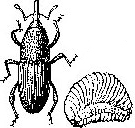
 Granary weevil, left; weevil larva, middle; rice weevil, right.
Granary weevil, left; weevil larva, middle; rice weevil, right.
Beetles of the family Curculionidae are characterized by a head that is elongated into a snout. Two species in this large family, the rice weevil and granary weevil, are common pests of stored whole grains in the pantry. Adults feed on the outside of grain kernels while the white, legless, grublike larvae feed and develop inside the kernels.
The granary weevil is about 3/16 inch long and is chestnut brown to black. There are no functional wings under the wing covers, so it does not fly. Adults and larvae feed on a wide variety of grains. The adult female uses her mandibles to bore a small hole into the outside of the kernel, then deposits an egg into the hole and covers it with fecal cement. The larva hatches and develops entirely inside the kernel. Developmental time from egg to adult is about four weeks. The rice weevil is almost 1/8 inch long, reddish brown to nearly black and marked with four light red to yellow spots on the wing covers. Unlike the granary weevil, it has a pair of wings under the wing covers and can fly. However, its biology and habits are similar to those of the granary weevil.
Spider beetles
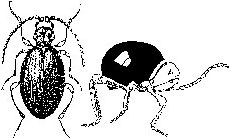 Brown spider beetle, left; American spider beetle, right.
Brown spider beetle, left; American spider beetle, right.
Several species of beetles of the family Ptinidae may be found infesting all types of stored food products. These beetles have long legs and a general spiderlike appearance. Both adult beetles and their C-shaped, grublike larvae feed on infested materials. Under favorable conditions, the development time from egg to adult is about three and a half months.
Mealworms
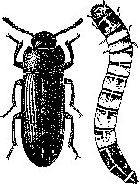 Mealworm.
Mealworm.
The term mealworm is applied to the larvae of several species of beetles of the family Tenebrionidae. Mealworms are the largest insects that infest cereal products. Larvae are normally associated with cereal grain products that are damp or in poor condition and that are stored in undisturbed out-of-the-way places such as basements.
Yellow mealworm and dark mealworm
The adult yellow mealworm is a polished dark brown to black beetle usually just over 1/2 inch long. The adult dark mealworm is similar to the yellow mealworm except that it is a dull, pitch black. Full-grown larvae of both species are active and are about an inch long, tubular and rather hard shelled. Yellow mealworm larvae are yellowish brown, while dark mealworm larvae are dark brown. Developmental time from egg to adult is about a year in good conditions. The larval stages of both species are often reared en masse as food for pets in pet stores. Such "food" brought home with pets may be the source of an infestation.
Flour moths
Flour moths are moths that infest processed grain products. They are some of the most common pantry pests in Missouri. Adult moths with a wingspan of about 3/4 inch are seen flying around infested areas. Damage to stored food products is done by the caterpillars, which reach a length of about 1/2 inch. Development from egg to adult takes about seven weeks, depending on species and environmental conditions.
Indian meal moth
 Indianmeal moth.
Indianmeal moth.
This is probably the most common pantry pest in Missouri homes. The marks on the forewings of the adult moth are distinctive for identification. The wings are slightly over 1/2 inch long, coppery colored on the distal two-thirds and a whitish gray on the basal ends. Caterpillars are about 1/2 inch in length and range in color from dirty white to greenish and pinkish. They leave a silken thread behind them wherever they crawl, thus forming webs across the surface of infested food. These larvae eventually leave the infested material and migrate to find a snug place to spin their silken cocoons. Many infestations are discovered when a homeowner sees these small caterpillars crawling across the countertop, cabinet or ceiling.
Mediterranean flour moth
This moth is slightly larger than the Indian meal moth. Its forewings are pale gray with many black lines running across them. The larval appearance and habits are similar to Indian meal moths.
Grain moths
The term grain moth is applied to moths whose larvae develop in whole, unbroken grain kernels. Several species of these moths exist, but only one is commonly found infesting the pantry.
Angoumois grain moth
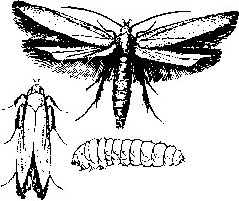 Angoumois moth.
Angoumois moth.
This is a tiny buff to yellowish moth with a wingspan of almost 1/2 inch. The hind wings have a distinctly pointed appearance. These moths often are confused with clothes moths. The main difference is that these moths actively fly around the house, while clothes moths shun light and usually are seen only in closets. Popcorn is a commonly infested food. Eggs may be laid on popcorn in the field or, more frequently, in storage. Developmental time is about five weeks.
Psocids

 Grain mite, left; psocid, right.
Grain mite, left; psocid, right.
Psocids are tiny insects about the size of a pinhead. They are often called book lice. Five different species may infest stored products. These insects are pale gray or yellowish white, wingless, soft-bodied, louse-like insects with poorly developed eyes and long, slender antennae. They often are found infesting food products stored under moist conditions. Actual damage to the food products is hardly detectable, so they are considered pests primarily because their presence contaminates the food. Developmental time is about three weeks for most species.
Grain mites
Grain mites are small, pale grayish, wingless, soft-bodied creatures. They often are found in stored grain and eventually may be brought into the home in grain food products. In damp conditions, they build up rapidly to populations that make infested food seem to be alive with the mites. Developmental time is about two weeks.
Control
Preventing and eliminating infestations of stored product pests consists of proper storage, sanitation and follow-up. Following all of these recommendations will minimize the risk of infestation.
Prevention
- Be aware of stored product pests that may be brought into your home on food items. Be especially suspicious of birdseeds and pet foods. Purchasing large quantities of these products that sit for long periods is an invitation for trouble.
- Make sure your home is in good condition to minimize invasions of stored product pests from outside. Good screening is critical, caulking around window and doorframes is necessary, and gaps under exterior doors should be eliminated.
- Adequate ventilation in storage areas to minimize mold and mildew growth is important.
- Store susceptible foods in tight containers — especially foods that will sit for long periods of time without being disturbed.
- Remove spilled food products from storage areas and replace torn or damaged storage containers immediately.
Elimination
- Carefully examine all susceptible foods to determine all sources of infestation. Remember that inedible items may be suitable for some stored product pests, so don't forget to check prescription drugs, cosmetics and spices. Throw away items that are infested by putting them in tightly sealed bags and taking them outside of the storage area to a trash bin for prompt removal.
- If infested items have high value, or if the infestation is questionable, you can heat the items to 130 degrees Fahrenheit for at least 30 minutes or place in a deep freezer at zero degrees for at least four days. Freezing may be particularly helpful for prescription drugs or cosmetics that are expensive and may still be perfectly useable after killing the infestation. Insects that occur in whole kernels of grain can be controlled by heat or cold treatments. Heat should not be used on popcorn for obvious reasons. Seeds kept for planting should not be subjected to heating or freezing, because such treatment may affect germination.
- Empty and clean the storage area and shelves thoroughly with a vacuum cleaner and hot soapy water.
- Optional: After a thorough cleaning, you may choose to apply a mild insecticide to cracks and crevices in the storage area where pests could be hiding. Check the label to ensure the product can be used indoors for the stored product pest you have. The most commonly used insecticides for this purpose are pyrethroids (active ingredient ending in -thrin). Common pyrethroid active ingredients include pyrethrin, cyfluthrin and cyhalothrin.